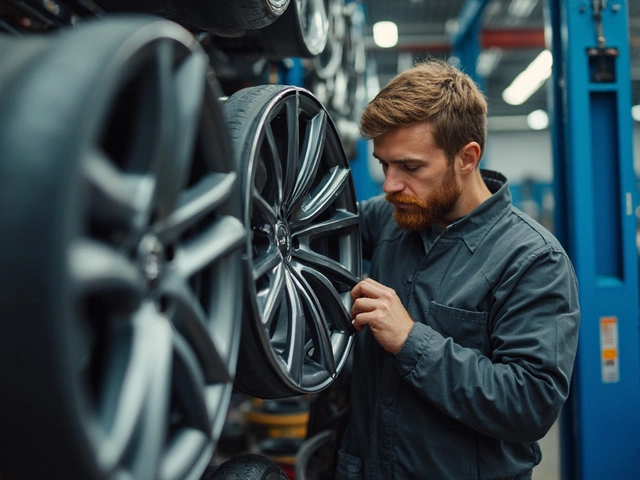Ever hit a bump and felt like your car was going to bounce right off the road? Yeah, that's likely because of your suspension system doing its job, or not. A car's suspension isn't just there for comfort; it plays a crucial role in your vehicle's handling, safety, and overall performance. You might think it's all about springs and dampers, but there's more going on down there than you might expect.
Imagine your car's suspension as a team of unsung heroes, each part chipping in to keep you steady. You’ve got your shocks and struts, which help absorb all those nasty bumps, making sure you don't feel every little crack on the road. Then, there's the springs—coil or leaf—that work to support the vehicle's weight and maintain ride height.
But wait, there's more! Control arms might not sound all that glamorous, but they play a big part in connecting the wheels to the car's frame and allowing for controlled up-and-down movement. And let's not forget the anti-sway bar, which helps reduce body roll during sharp turns, making sure you stick to the road like a pro.
- The Basics of Suspension Systems
- Key Components and Their Roles
- Common Suspension Issues
- Maintaining Your Suspension System
The Basics of Suspension Systems
Alright, so let’s kick things off with what a suspension system actually does. At its core, it’s all about keeping your car’s wheels planted firmly on the ground. Imagine driving without it; every bump would send you flying! The system absorbs all that shock from the road, ensuring you (and your coffee) stay nice and steady.
The suspension system is made up of a few main components. Most cars use a combination of springs, shocks or struts, and linkages. Each part plays a specific role in smoothing your ride. It's like an orchestra, where every instrument must work in perfect harmony. They come together to not only absorb shocks but also help with handling, turning, and even braking.
The most common type of suspension found in cars today is the independent suspension. That means each wheel is connected to the frame separately, which helps in better handling and comfort. You’ll often hear about MacPherson struts or double wishbone setups. These are fancy terms for different ways of connecting the moving parts that give you that sweet, smooth ride.
Now, it's not all about comfort—proper suspension is also a key player in car safety. It affects how well your car can stop and maneuver during unexpected situations. Think of it as the foundation that keeps everything in control.
If you’re one of those who love stats, consider this: an optimally performing suspension system can improve tire contact with the road by up to 30%. How’s that for bragging rights?
Key Components and Their Roles
Alright, let's dive into what makes up the heart of your car's suspension system. The key players are the shocks, struts, springs, control arms, and anti-sway bars, each with their own important job.
Shocks and Struts: These guys are basically the shock absorbers of your car. The main idea here is to keep your ride smooth by absorbing and dampening the energy from the road. Shocks are used when the suspension system has separate springs, while struts are a two-in-one deal combining the shock and some structural support.
Springs: These are your main suspension support, coming in coil or leaf varieties. Sprung weight is the weight above the suspension, while unsprung weight is the stuff hanging from it like wheels and brakes. Coil springs are popular for small to medium vehicles, while leaf springs are more old-school, typically found in larger trucks.
Control Arms: Think of these as the arms that link the wheels to your vehicle's frame. They not only allow for up-and-down movement but also keep the wheels stable as the car turns. Picture them as the part that lets your wheels hug the road while still moving independently over bumps.
Anti-Sway Bars: When you take a sharp corner and your car feels steady instead of like a roller coaster, thank the anti-sway bar. This part connects the left and right sides of your suspension, reducing body roll to enhance handling. It’s crucial for making sure you stay on track, literally.
To give you a quick snapshot of how these components add to vehicle smoothness, check out this simple breakdown of component functions:
| Component | Function |
|---|---|
| Shocks and Struts | Absorb road impacts, maintain vehicle stability |
| Springs | Support vehicle weight and maintain height |
| Control Arms | Stabilize wheels, allow for movement |
| Anti-Sway Bars | Reduce body roll during turns |
Each of these elements is designed to work in harmony, so you're not bouncing down the road or tipping over in tight turns. Whether you’re commuting or just enjoying a Sunday drive, knowing what these suspension parts do can help you appreciate the complexity that goes into a seemingly simple ride.

Common Suspension Issues
So, you're cruising down the highway, and suddenly, your car starts to wobble like jelly on a plate. Not ideal, right? These suspension parts are generally tough, but like anything, they can run into problems over time. Let's chat about some of the common headaches you might face with your car's suspension system.
Worn-out Shocks and Struts are often the usual suspects when your ride gets rough. These components are key players in absorbing impact and maintaining a smooth drive. If you start feeling every little bump, it might be time to check them out. Typically, they need replacement every 50,000 miles or so, depending on how you treat your car.
Another issue is sagging springs. If one corner of your car seems lower than the rest, your springs might be giving up. Springs are what bear the weight of your vehicle, and when they lose their springiness, they can affect your car's ride height and comfort.
Now, let's talk about broken control arms. These bits let your wheels move up and down while staying aligned with the car body. A broken control arm isn't just annoying; it can be dangerous, causing steering problems and uneven tire wear.
And don't forget about bushing wear. Bushings are small but mighty, working to keep parts like control arms in place. Worn bushings might not sound serious, but they can cause clunking noises and vibration.
- Shocks and Struts: Keep an eye out for leaking oil or noticeable bouncing.
- Springs: Look for visible sagging or uneven ride height.
- Control Arms: Check for steering play or strange noises when turning.
- Bushings: Listen for clunks over bumps and watch for wandering steering.
Lastly, a neat little fix can sometimes be just balancing the tires or checking alignment. Misaligned wheels can mimic suspension system problems, leading to a crooked steering wheel and uneven tire wear.
Maintaining Your Suspension System
Keeping your car's suspension parts in good shape isn't just about a smooth ride—it's also key to safe driving and good handling. Regular maintenance can save you from expensive repairs and unexpected breakdowns. So, how do you keep everything in tip-top condition?
First off, make checking your suspension system a regular habit, just like you would with oil changes. You don't need to be a mechanic to do a basic visual check. Look for signs of wear like rust, cracks, or leaks around your shocks, struts, and springs. If you spot something that doesn't look right, it's time to visit the mechanic.
It's also a good idea to listen to your car. Odd noises like squeaking, clunking, or excessive bouncing over bumps can indicate a suspension issue. Ignoring these sounds could mean minor issues become major headaches.
Pay attention to how your vehicle feels while driving, especially on uneven roads. If your car is pulling to one side or seems to have a mind of its own when steering, your suspension system might be telling you something's up.
- Get your alignment checked regularly. Misalignments not only wear out tires faster but also add stress to your suspension parts.
- Replace worn shocks or struts as soon as possible. It's crucial because they can affect braking efficiency and handling.
- Ensure your tires are properly inflated. Under- or over-inflated tires can cause uneven wear and affect the suspension.
If you’re unsure about the health of your suspension, get a professional inspection. They can spot issues you might miss and recommend solutions to keep you and your passengers safe on the road.






